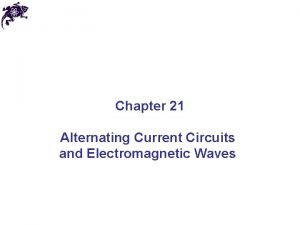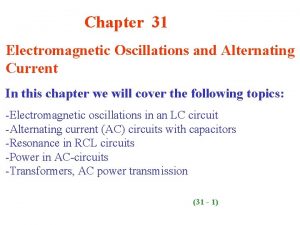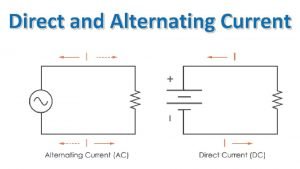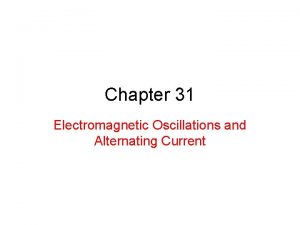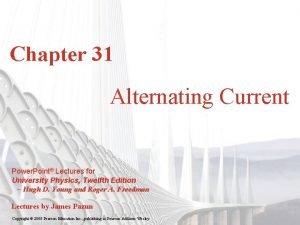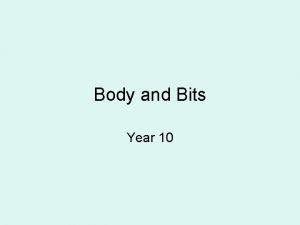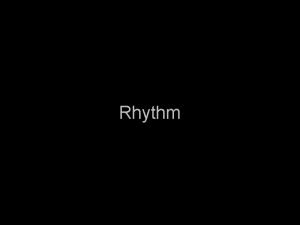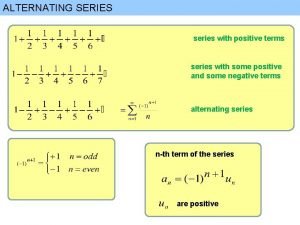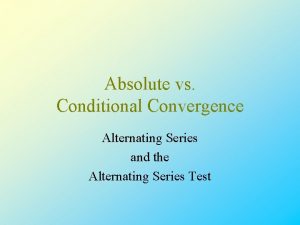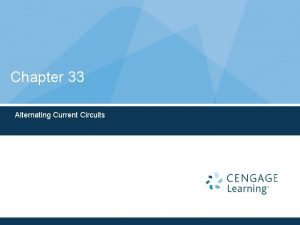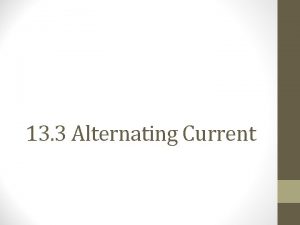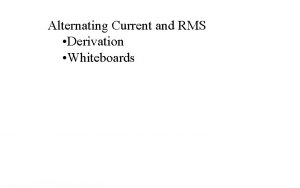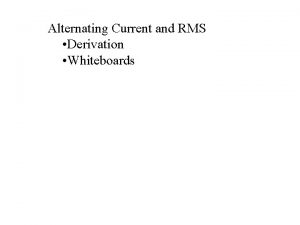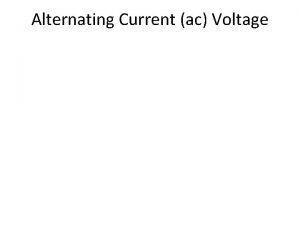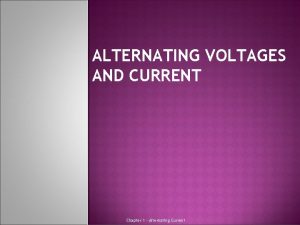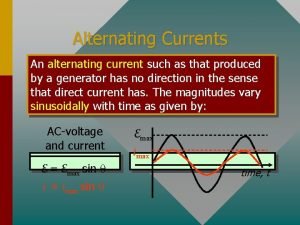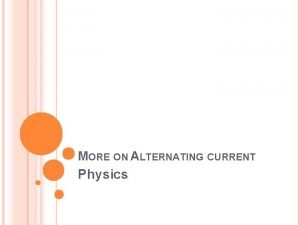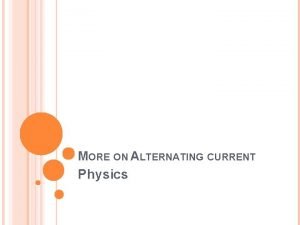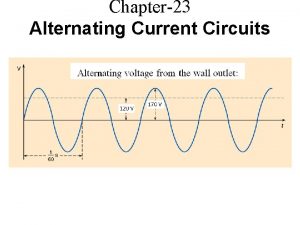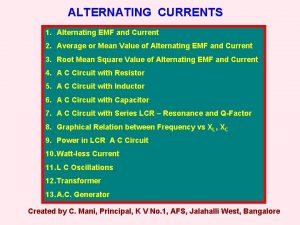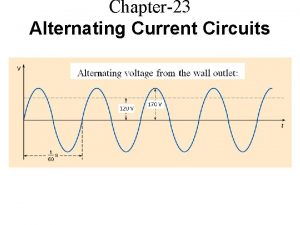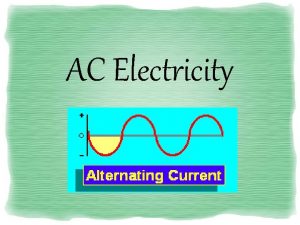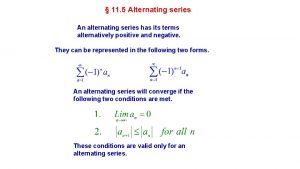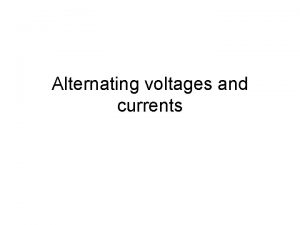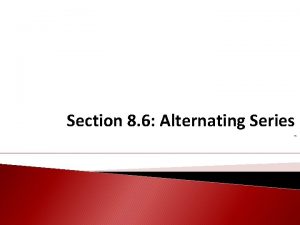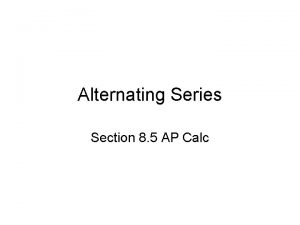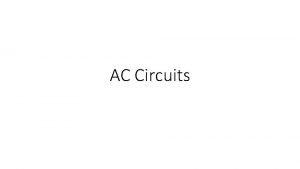Alternating Current Assist Prof Dr Ayta Gren Assist







![Behaviors of Basic Circuit Components under AC Adding a 5 [Ohm] resistor to this Behaviors of Basic Circuit Components under AC Adding a 5 [Ohm] resistor to this](https://slidetodoc.com/presentation_image_h/25114ec10891d10f5a82aacabefe502b/image-8.jpg)




























- Slides: 36

Alternating Current § Assist. Prof. Dr. Aytaç Gören § Assist. Prof. Dr. Şahin Yavuz Alternating Current 5. 3. 2021

Contents Alternating Voltage Phasor Representation of AC Behaviors of Basic Circuit Components under AC Resistance, Reactance and Impedance Power in AC Circuits Alternating Current 2

Behaviors of Basic Circuit Components under AC Capacitors react different due to the voltage level applied to them under alternating current. If the voltage level applied is greater than the voltage on a capacitor, the source charges the capacitor; in opposite case, capacitor behaves like a source. The current equation for a capacitor is: Alternating Current 3

Behaviors of Basic Circuit Components under AC Alternating Current 4

Behaviors of Basic Circuit Components under AC The phase difference between voltage and current is 90 degrees on a capacitor or in other words, current leads voltage 90 degrees. This case results with negative electrical power which means that capacitor transfers power to the circuit (i. e. Capacitor discharges its electrical charge). The ‘resistance’ of the capacitors change due to the frequency of the alternating voltage. The higher frequency of the AC signal, the more easily that signal will pass through the capacitor. Thus, this is called as capacitive reactance, Xc. Alternating Current 5

Behaviors of Basic Circuit Components under AC Let us examine the behavior of the capacitor in the circuit mathematically. The current can be found using the capacitive reactance equation and the implementation of Ohm’s Law to AC easily. Alternating Current 6

Behaviors of Basic Circuit Components under AC The current of the AC source leads the voltage of the source 90 degrees. The resistance effect of the capacitor to AC source is calculated considering this. Alternating Current 7
![Behaviors of Basic Circuit Components under AC Adding a 5 Ohm resistor to this Behaviors of Basic Circuit Components under AC Adding a 5 [Ohm] resistor to this](https://slidetodoc.com/presentation_image_h/25114ec10891d10f5a82aacabefe502b/image-8.jpg)
Behaviors of Basic Circuit Components under AC Adding a 5 [Ohm] resistor to this circuit, let us calculate the total effect of the resistor and the capacitor. The total resistance in this circuit is found as: Alternating Current 8

Behaviors of Basic Circuit Components under AC Implementing the Ohm’s Law to the circuit, the current is calculated. In this analysis, the phase of the source is always zero (0). As it can be considered easily, the phase shift is 79. 325 degrees in this circuit whereas in the circuit that has only one capacitor it was 90 degrees. Alternating Current 9

Behaviors of Basic Circuit Components under AC Using phasor diagrams, Let us examine the last table carefully. The current and the voltage on the resistor is on the same phase as it is mentioned. However, the current on a capacitor leads voltage by 90 degrees. Alternating Current 10

Behaviors of Basic Circuit Components under AC Parallel Resistor – Capacitor Circuit Alternating Current 11

Behaviors of Basic Circuit Components under AC Alternating Current 12

Behaviors of Basic Circuit Components under AC Resistor, Reactance and Impedance The resistance against the current can be in three types: 1. Resistor: It is the friction of electrons during motion. Its symbol is “R” and unit is [ ] (i. e. [Ohm]). It does not form any phase shift. 2. Reactance: It is the inertia of electrons. It occurs if there is a change in voltage or current values (if an electric or magnetic field occurs). The capacitor and inductor are the main circuit components which this influence is highly distinct. If there is a reactance effect in a circuit, there is also phase shift. If the component is a capacitor, the current leads voltage by 90 degrees whereas if it is an inductance, the current lags voltage by 90 degrees. Alternating Current 13

Behaviors of Basic Circuit Components under AC 3. The impedance, is the strain against the current in an electrical circuit. In aother words, it is the resistance against the motion of electrons. Impedance is the total resistance and reactance effects of all components. The resistance in DC circuits is the impedance in AC’s. The AC implemented Ohm’s Law can be seen as below. Please consider that all the quantities are in complex number form in the equation below : Like Ohm’s Law, other laws (Kirrschoff’s, grid theorems, etc. ) used in circuit analysis can be also implemented in AC in condition of using complex numbers. It is the power calculations that the AC and DC calculations differes. The next subject will be about this case. Alternating Current 14

Behaviors of Basic Circuit Components under AC Resistor (R) Coil (L) (Inductor) Capacitor(C) (Condenser) Alternating Current 15

Behaviors of Basic Circuit Components under AC Serial R-L-C Circuits Alternating Current 16

Behaviors of Basic Circuit Components under AC Alternating Current 17

Behaviors of Basic Circuit Components under AC Alternating Current 18

Behaviors of Basic Circuit Components under AC It should be considered that the amplitude of the voltage on the capacitor is greater than the voltage supplied to the circuit. The reason is that the influence of the reactance of the coil effects just the opposite according to the influence of the reactance of the coil to the circuit. The influence of the impedance in the whole circuit is smaller than the influence of impedance of any single component. This case causes higher voltages on single components. However, this does not change the Kirchhoff’s Law about the total voltages in a circuit (0+0 j). Alternating Current 19

Behaviors of Basic Circuit Components under AC Parallel R-L-C Circuit Alternating Current 20

Behaviors of Basic Circuit Components under AC Alternating Current 21

Behaviors of Basic Circuit Components under AC Alternating Current 22

Behaviors of Basic Circuit Components under AC Serial and Parallel Circuits Alternating Current 23

Behaviors of Basic Circuit Components under AC The calculation of impedance in this circuit should be completed step by step. First, serial connection branch of C 2 and L, afterwards the parallel branch of resistor and last the serial capacitor effects should be calculated. Alternating Current 24

Behaviors of Basic Circuit Components under AC Alternating Current 25

Behaviors of Basic Circuit Components under AC Alternating Current 26

Behaviors of Basic Circuit Components under AC Alternating Current 27

Power in AC Circuits Since it was mentioned, there is a phase shift between current and voltage in AC circuits. The reason is the impedance as it was stated. There are three definitions in AC circuits which are related with power. These are: True power (active power), Reactive power, Apparent power. Alternating Current 28

Power in AC Circuits The reactive power that is referring to the influence of reactance is: The apparent power is the power related with the impedance: Alternating Current 29

Power in AC Circuits The power quantities are scalar quantities. It is a prependicular triangle that we get if we draw the calculated values, considering the 90 degrees of direction angle between the resistor and the reactance and phase shift in the circuit. This triangle is called as ‘Power Triangle’. As it is seen in this triangle, a part of the power is lost in an AC circuit. The generated effective power is just as the true power. Power factor is the cosine of the angle between the true and apparent powers (cos ). This value is equal to 1 in only circuits those have just resistors. But if there is a reactance, then the value is between 0 and 1. Alternating Current 30

Power in AC Circuits To examine the effect of the reactance, let us calculate the P, Q and S powers in this circuit. The power factor of this circuit may be found using the definition below. Alternating Current 31

Power in AC Circuits The power factor value shows that the 70. 5 % of the power used from the grid is served for the purpose. This situation is not wanted. So, in circuit design stage, it must be noted that the power factor is approximately equal to 1. For this reason, the capacitive and inductive ractance values should be equal to each other. If this is not possible, a capacitor or an inductor should be externally added to the circuit. This improvement is called as compensation. Now, let us calculate the reactance of the same circuit. Alternating Current 32

Power in AC Circuits The ractance in this circuit is inductive. In othe words, the coil is the reason of ractance. To compensate this, let us add a capacitor to the circuit. Using the calculations below, the capacitor value that can form a capacitive ractance to generate the same inductive ractance value but in opposite direction might be found. Alternating Current 33

Power in AC Circuits The capacitor value found is not a standart value for capacitors, so the closest standart value shold be chosen (22 µF) and connected in parallel with the circuit. Now let us examine this case: The new impedance value is: Alternating Current 34

Power in AC Circuits And the new power factor is: As seen above, this improvement made the power factor closer to 1. Besides, the current is decreased. These two results indicate that the circuit is improved in means of efficiency and economic. Alternating Current 35

Alternating Current
 Alternating current circuits and electromagnetic waves
Alternating current circuits and electromagnetic waves Direct current transformer
Direct current transformer Electromagnetic oscillations and alternating current
Electromagnetic oscillations and alternating current Chapter 7 alternating current
Chapter 7 alternating current Direct and alternating current
Direct and alternating current Electromagnetic oscillations and alternating current
Electromagnetic oscillations and alternating current A psu converts alternating current to what
A psu converts alternating current to what Alternating current ppt
Alternating current ppt Ent1883
Ent1883 Ac dc graph
Ac dc graph Mrs gren meaning
Mrs gren meaning Mrs gren
Mrs gren Science mrs gren
Science mrs gren Postapoplektisk epilepsi
Postapoplektisk epilepsi Characteristics of living things mrs gren
Characteristics of living things mrs gren Mrs gren c
Mrs gren c Balanced delta-wye connection
Balanced delta-wye connection Y connected generator
Y connected generator Touch current vs leakage current
Touch current vs leakage current Drift current and diffusion current in semiconductor
Drift current and diffusion current in semiconductor Holding current and latching current
Holding current and latching current Line current and phase current
Line current and phase current Mesh current method with current source
Mesh current method with current source Drift current and diffusion current
Drift current and diffusion current Diffusion current density
Diffusion current density N=nc exp(-eg/2kt)
N=nc exp(-eg/2kt) The constant-current area of a fet lies between
The constant-current area of a fet lies between A splice in a welding cable should never be any closer than
A splice in a welding cable should never be any closer than Ac systems lesson 4
Ac systems lesson 4 Legato rhythm in art
Legato rhythm in art Multi element design
Multi element design Absolute vs conditional convergence
Absolute vs conditional convergence Cover uncover test vs alternating cover test
Cover uncover test vs alternating cover test Ratio test for absolute convergence
Ratio test for absolute convergence Absolute vs conditional convergence
Absolute vs conditional convergence Worth 4 dot test
Worth 4 dot test Compare and contrast organization
Compare and contrast organization
